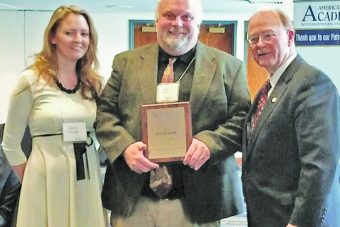
May 26, 2016 IN: Awards, News

McCrone received an Excellence in Engineering 2016 Honor Award from the American Academy of Environmental Engineering and Sciences (AAEES) for Cultural Integration in Wastewater Treatment—SBA Temple.
The AAEES recognizes organizations and individuals who have made contributions to environmental engineering, environmental science, and public health/environmental protection at their annual Awards Luncheon at the National Press Club in Washington, DC. The winning entries for the AAEES awards were from Guatemala, Washington, DC, California, Virginia, South Carolina, Texas, Florida, Colorado, and McCrone was the only award winner representing Maryland.
McCrone’s Public Works office had the unique opportunity to design a wastewater treatment and disposal system for Sri Bhaktha Anjaneya (SBA) Temple, a Hindu worship center located in Frederick County, MD. The project involved integration of wastewater flows from a nontraditional place of worship into current wastewater systems design guidelines. The majority of state design guidelines and regulations were created decades ago and are not all culturally inclusive.
Project Manager Rob Sell, P.E., realized the challenges of the project and was enthusiastic about the opportunities to contribute to Maryland’s flowrates database and learn about new “wastewater culture.” Rob worked closely on the project with Natalia Dunlap, P.E., who played a key role in its success.
There were several engineering design challenges related to the project’s cultural uniqueness. One challenge was to establish the wastewater flowrate from the Temple. Typically, the flow from a church is established by multiplying the number of seats in the church by a flow factor per seat. However, a Hindu temple does not have a seating layout, but instead there is an open space design. Since the state and local health department did not have a standard flow factor per devotee or seat applicable to Hindu temples, the state and local officials accepted McCrone’s suggestion to compare the facility’s use to a high school with a limited food service cafeteria. Using data obtained from this comparison, and then visiting other jurisdictions to obtain flow data from existing temples, McCrone was able to successfully derive wastewater flow factors for this project.

The main components of the treatment system are pictured above: primary tank, equalization tank, treatment tanks, controls, alkalinity feed system, aeration (two blowers) and dosing pumping station (low pressure dosing fields installed downstream of the treatment plant).
There are certain ceremonial procedures specific to Hindu temples that impact wastewater discharge. For example, it is customary for devotees to wash their feet when they enter the Temple. Temple objects of worship are bathed in Holy Water comprised of a solution that includes milk, yogurt, honey, and herbs. State and local government guidelines typically require only one treatment and disposal system per property, but since discharged Holy Water cannot be mixed with human waste, McCrone obtained approval and designed a separate disposal system for the Holy Water to accommodate religious aspects of the project.
The state and local government requires a safety factor for the wastewater flowrate, however, there are no standard peaking factors for places of worship like temples. There are also no textbook or literature sources suggesting a safety factor on wastewater discharge for Hindu temples. McCrone derived a safety factor by using real-life data from two existing Hindu temples in Maryland under WSSC jurisdiction and subsequently contributed it to Maryland’s flowrate database for others to use.
McCrone’s engineering expertise went beyond the design parameters for an unconventional project to integrate a different culture through the world of wastewater treatment. The McCrone team submitted its research report to Maryland Department of Environment (MDE) for inclusion in the new established wastewater flow parameter in “MDE Guidance on Wastewater Flows for Use in Designing On-Site Systems.”
For more information about this project or how McCrone may assist you with your next water or wastewater project, please contact Rob Sell or Natalia Dunlap at 410-267-6947.